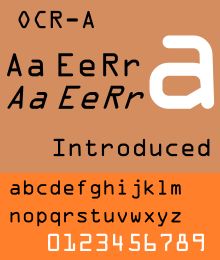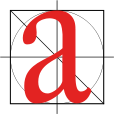- OCR-A font
-
OCR-A 
Category Sans-serif Designer(s) American Type Founders Commissioned by American National Standards Institute Date released 1968[1] Variations OCR-A Extended In the early days of computer optical character recognition, there was a need for a font that could be recognized by the computers of that day, and by humans.[2] The resulting compromise was the OCR-A font, which used simple, thick strokes to form recognizable characters[3]. The font is monospaced (fixed-width), with the printer required to place glyphs 0.254 cm (0.10 inch) apart, and the reader required to accept any spacing between 0.2286 cm (0.09 inch) and 0.4572 cm (0.18 inch).
Contents
Standardization
The OCR-A font was standardized by the American National Standards Institute (ANSI) as X3.4-1977. X3.4 has since become the INCITS and the OCR-A standard is now called ISO 1073-1:1976. There is also a German standard for OCR-A called DIN 66008.
Implementations
In 1968, American Type Founders produced OCR-A, one of the first optical character recognition typefaces to meet the criteria set by the U.S. Bureau of Standards. The design is simple so that it can be easily read by a machine, but it is more difficult for the human eye to read.[4][5]
As metal type gave way to computer-based typesetting, Tor Lillqvist used MetaFont to describe the OCR-A font. That definition was subsequently improved by Richard B. Wales. Their work is available from CTAN.[6]
To make the free version of the font more accessible to users of Microsoft Windows, John Sauter converted the MetaFont definitions to TrueType using potrace and FontForge in 2004.[7] In 2007, Gürkan Sengün[8] created a Debian package from this implementation.[9]
In 2008. Luc Devroye corrected the vertical positioning in John Sauter's implementation, and fixed the name of lower case z.[10]
Independently, Matthew Skala used mftrace[11] to convert the Metafont definitions to TrueType format in 2006. In 2011 he released a new version created by rewriting the Metafont definitions to work with METATYPE1, generating outlines directly without an intermediate tracing step.[12]
In addition to these free implementations of OCR-A, there are also implementations sold by several vendors.
Use
Although optical character recognition technology has advanced to the point where such simple fonts are no longer necessary, the OCR-A font has remained in use. Some lockbox companies still insist that the account number and amount owed on a bill return form be printed in OCR-A. In addition, some people prefer its unique style.
Code points
A font is a set of character shapes, or glyphs. For a computer to use a font then each glyph must be assigned a code point in a character set. When OCR-A was being standardized the usual character coding was the American Standard Code for Information Interchange or ASCII. Not all of the glyphs of OCR-A fit into ASCII, and for five of the characters there were alternate glyphs, which might have suggested the need for a second font. However, for convenience and efficiency all of the glyphs were expected to be accessible in a single font using ASCII coding, with the additional characters placed at coding points that would otherwise have been unused.
The modern descendant of ASCII is Unicode, also known as ISO 10646. Unicode contains ASCII and has special provisions for OCR characters, so some implementations of OCR-A have looked to Unicode for guidance on character code assignments.
Space, digits, and unaccented letters
All TrueType implementations of OCR-A use U+0020 for space, U+0030 through U+0039 for the decimal digits, U+0041 through U+005A for the unaccented upper case letters, and U+0061 through U+007A for the unaccented lower case letters.
Regular characters
In addition to the digits and unaccented letters, many of the characters of OCR-A have obvious code points in ASCII. Of those that do not, most, including all of OCR-A's accented letters, have obvious code points in Unicode.
Remaining Characters
John Sauter coded the remaining characters of OCR-A as follows:
Exceptions
Some implementations do not use the above code point assignments for some characters.
PrecisionID
The PrecisionID implementation of OCR-A has the following non-standard code points:[13]
- OCR Hook at U+007E
- OCR Chair at U+00C1
- OCR Fork at U+00C2
- Euro Sign at U+0080
Barcodesoft
The Barcodesoft implementation of OCR-A has the following non-standard code points:[14]
- OCR Hook at U+0060
- OCR Chair at U+007E
- OCR Fork at U+005F
- OCR Belt Buckle at U+00DD
Moravia
The Moravia implementation of OCR-A has the following non-standard code points:[15]
- OCR Hook at U+007E
- OCR Chair at U+00F0
- OCR Fork at U+005F
- Vertical Line at U+007C
IDAutomation
The IDAutomation implementation of OCR-A has the following non-standard code points:[16]
- OCR Hook at U+007E
- OCR Chair at U+00C1
- OCR Fork at U+00C2
- OCR Belt Buckle at U+00C3
In addition, the IDAutomation implementation of OCR-A includes the Euro Sign character. The IDAutomation documentation does not specify the code point for the Euro Sign character. Since the code points for OCR Hook, OCR Chair and OCR Fork match those of PrecisionID, the IDAutomation OCR-A font may be a clone of the PrecisionID OCR-A font, in which case the Euro Sign would be coded as U+0080. The standard code point for Euro Sign is U+20AC.
OCR-A Extended
OCR-A Extended is an expanded version of the OCR-A font with 251 glyphs, 62 of which are composite glyphs, supporting the following languages in addition to English[citation needed]:
- French
- German
- Italian
- Portuguese
- Dutch
- Spanish
- Icelandic
- Norwegian
- Danish
- Finnish
- Swedish
- Albanian
Sellers of font standards
- Hardcopy of ISO 1073-1:1976, distributed through ANSI, from Amazon.com
- ISO 1073-1 is also available from Techstreet, who distributes standards for ANSI and ISO
See also
- MICR
- Optical character recognition
- Westminster (typeface), another typeface designed to be machine-readable.
- OCR-B
Notes
- ^ Background information about OCR-A from Linotype
- ^ Motivation for OCR-A from Monotype and Linotype
- ^ Background on OCR from Embedded Software Engineering
- ^ Background on OCR-A from Adobe
- ^ Some history of OCR fonts
- ^ The MetaFont sources for OCR-A from CTAN
- ^ John Sauter's 2004 OCR-A font from those MetaFont sources
- ^ Gürkan Sengün's home page in Launchpad
- ^ The ttf-ocr-a Debian package, based on John Sauter's SourceForge project
- ^ Luc Devroye's font page, search for Sauter
- ^ The mftrace Debian package
- ^ Matthew Skala's 2011 OCR-A font from the MetaFont sources
- ^ PrecisionID User Guide for the PrecisionID implementation of the OCR-A font
- ^ Information page for the Barcode implementation of the OCR-A font
- ^ Information page for the Moravia implementation of the OCR-A font
- ^ Information page for the IDAutomation implementation of the OCR-A and OCR-B fonts
External links
- Information page of linotype.com OCR-A
- Introductory article about OCR fonts
- Link standard ANSI INCITS 17-1981 (R2002)
- Background on ISO work involving OCR-A
- Unicode code charts
- Debian package ttf-ocr-a
- Web-page where possible to download a free version of OCR-A
Free and Open Source Typography Operating system typefaces - GNU FreeFont
- Ghostscript fonts
- GNU Unifont
- Cantarell
- Droid
- Liberation
- Ubuntu
Other typefaces - Allerta
- Asana-Math
- Beteckna
- Bitstream Vera
- Caslon Roman
- Chandas
- Charis SIL
- Computer Modern
- DejaVu
- Doulos SIL
- Fixedsys Excelsior
- Gentium
- HyperFont
- Inconsolata
- Junicode
- Kochi
- Latin Modern
- Linux Libertine
- M+
- Nimbus Mono
- Nimbus Roman
- Nimbus Sans
- OCR-A
- OCR-B
- PT Sans
- Taigi Unicode
- Tiresias
- Ubuntu-Title
- WenQuanYi
- XITS
Software Licenses - SIL Open Font License
- Ubuntu Font Licence
Groups and People Open-source Unicode Typefaces - List of open source typefaces
- List of free software Unicode typefaces
Typography terminology Page 
Paragraph Character Typeface anatomyCounter · Diacritics · Dingbat · Glyph · Initial · Kerning · Letter-spacing · Ligature · Subscript and superscript · Swash · Text figuresCapitalizationVertical aspectsClassifications Punctuation Typesetting Calligraphy · ETAOIN SHRDLU · Font (Computer font) · Font catalog · Letterpress · Lorem ipsum · Movable type · Pangram · Phototypesetting · Punchcutting · Type design · Typeface · Type foundry · MicrotypographyTypographic units Digital typography ISO standards Lists: List of ISO standards · List of ISO romanizations · List of IEC standards
Categories: Category:ISO standards · Category:OSI protocols1
to
99991 · 2 · 3 · 4 · 5 · 6 · 7 · 9 · 16 · 31 (-0, -1, -2, -3, -4, -5, -6, -7, -8, -9, -10, -11, -12, -13) · 128 · 216 · 217 · 226 · 228 · 233 · 259 · 269 · 302 · 306 · 428 · 518 · 519 · 639 (-1, -2, -3, -5, -6) · 646 · 690 · 732 · 764 · 843 · 898 · 1000 · 1004 · 1007 · 1073-1 · 1413 · 1538 · 1745 · 2014 · 2015 · 2022 · 2108 · 2145 · 2146 · 2240 · 2281 · 2709 · 2711 · 2788 · 3029 · 3103 · 3166 (-1, -2, -3) · 3297 · 3307 · 3602 · 3864 · 3901 · 3977 · 4031 · 4157 · 4217 · 5218 · 5775 · 5776 · 5800 · 5964 · 6166 · 6344 · 6346 · 6425 · 6429 · 6438 · 6523 · 6709 · 7001 · 7002 · 7098 · 7185 · 7200 · 7498 · 7736 · 7810 · 7811 · 7812 · 7813 · 7816 · 8000 · 8178 · 8217 · 8571 · 8583 · 8601 · 8632 · 8652 · 8691 · 8807 · 8820-5 · 8859 (-1, -2, -3, -4, -5, -6, -7, -8, -9, -10, -11, -12, -13, -14, -15, -16) · 8879 · 9000/9001 · 9075 · 9126 · 9241 · 9362 · 9407 · 9506 · 9529 · 9564 · 9594 · 9660 · 9897 · 9945 · 9984 · 9985 · 999510000
to
1999910006 · 10118-3 · 10160 · 10161 · 10165 · 10179 · 10206 · 10303 (-11, -21, -22, -28, -238) · 10383 · 10487 · 10585 · 10589 · 10646 · 10664 · 10746 · 10861 · 10957 · 10962 · 10967 · 11073 · 11170 · 11179 · 11404 · 11544 · 11783 · 11784 · 11785 · 11801 · 11898 · 11940 · 11941 · 11941 (TR) · 11992 · 12006 · 12182:1998 · 12207 · 12234-2 · 13211 (-1, -2) · 13216 · 13250 · 13399 · 13406-2 · 13407 · 13450 · 13485 · 13490 · 13567 · 13568 · 13584 · 13616 · 14000 · 14031 · 14396 · 14443 · 14496-10 · 14496-14 · 14644 (-1, -2, -3, -4, -5, -6, -7, -8, -9) · 14649 · 14651 · 14698 · 14698-2 · 14750 · 14882 · 14971 · 15022 · 15189 · 15288 · 15291 · 15292 · 15408 · 15444 · 15445 · 15438 · 15504 · 15511 · 15686 · 15693 · 15706 · 15706-2 · 15707 · 15897 · 15919 · 15924 · 15926 · 15926 WIP · 15930 · 16023 · 16262 · 16750 · 17024 · 17025 · 17369 · 17799 · 18000 · 18004 · 18014 · 18245 · 18629 · 18916 · 19005 · 19011 · 19092-1 · 19092-2 · 19114 · 19115 · 19125 · 19136 · 19439 · 19501:2005 · 19752 · 19757 · 19770 · 19775-1 · 19794-520000+ See also: All articles beginning with "ISO" Categories:- Monospaced typefaces
- Sans-serif typefaces
- ISO standards
- Free software Unicode typefaces
- Open source typefaces
- Optical character recognition
- American Type Founders typefaces
Wikimedia Foundation. 2010.
